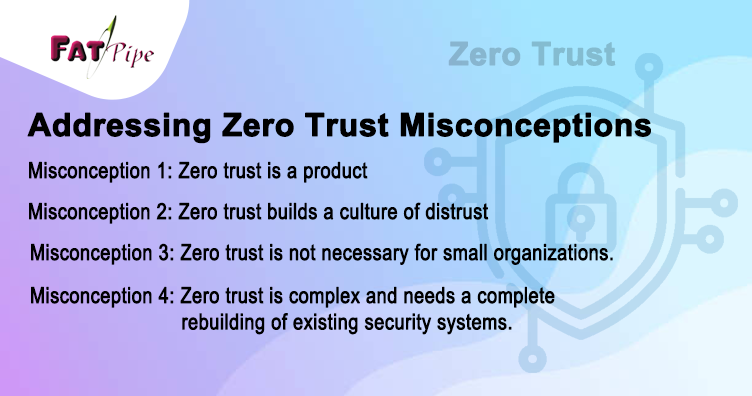Addressing Zero Trust Misconceptions: Embracing “Verify, Validate and Authorize” Procedure is Vital for Future-Proofing Your Organization

Zero Trust has been a widely discussed topic over the past few years, evolving from just a conceptual framework to a much-needed solution in cybersecurity. However, there are certain misconceptions that need to be cleared so that organizations can embrace it effectively and fully leverage its potential. FatPipe eliminates the misconceptions and helps organizations implement zero trust as their security procedure, ensuring that the latter benefit from it on a long-term basis.
Misconceptions Surrounding Adoption of ZTNA by Organizations
A small business may not adopt a zero trust framework with the notion that zero trust implementation is complex, may cause temporary disruptions in operations, they will not become target of cyberattacks, and so on. Large businesses too may think twice before implementing zero trust since they may believe that including zero trust in their security program is overwhelming (due to fear of overhauling existing infrastructure). These misconceptions need to be addressed so that organizations, irrespective of their size, gain utmost benefit from this powerful cybersecurity framework.
Clearing the Misconceptions
Misconception 1: Zero trust is not necessary for small organizations.
The essence of ZTNA is to address complex technology environments, be it small or large business. Small businesses have a wrong belief that they will not become targets of cyberattacks; in a recent survey, 41% of organizations mentioned they have implemented a zero trust security architecture, whereas 59% mentioned they haven’t. It is important to note that the size, industry, and other factors is not a bottleneck in implementing zero trust controls in an organization.
Misconception 2: Zero trust is complex and needs a complete rebuilding of existing security systems.
Zero trust’s true potential is often veiled by a lack of understanding within organizations, including a belief that zero trust needs a complete overhaul of existing security systems. FatPipe understands this concern, and through right solutions from expert teams converts complexity into simplicity with the right tools and systematic implementation thus streamlining zero trust. FatPipe has driven innovation in WAN simplification for nearly the past 20 years and now continues this simplification endeavor in the area of Secure Networks.
Misconception 3: Zero trust is a product.
It’s important to note that Zero Trust is not a product, but a strategic approach that ZTNA (Zero Trust Network Access) facilitates through dynamic access control procedures and strict authentication. FatPipe helps organizations benefit from a mature security environment, thereby reaping the benefits over time.
Misconception 4: Zero trust builds a culture of distrust.
Right from the advent of zero trust concept, organizations tend to confine it within the scope of a culture of distrust. However, zero trust only develops a proactive security mindset by ensuring that access is granted dependent on continuous verification rather than assumptions.
Conclusion
FatPipe’s “Verify, Validate, and Authorize” procedure provides the technologies and tools needed to implement Zero Trust, such as VPN, multifactor authentication, single sign-on solutions, intrusion prevention systems, etc. FatPipe allows businesses to select the security components that best meet their unique needs.






 In today’s digital landscape, data security is paramount for organizations across industries. With the proliferation of sensitive information, particularly Personally Identifiable Information (PII), robust security measures are essential to safeguard data integrity and confidentiality. FatPipe’s FIPS-compliant solutions, coupled with many other security features, offer peace of mind by implementing robust security measures and undergoing rigorous testing and validation processes. This not only helps organizations meet their own security requirements with appropriate encryptions and cryptographic hardware but also ensures compliance with regulatory obligations and contractual agreements.
In today’s digital landscape, data security is paramount for organizations across industries. With the proliferation of sensitive information, particularly Personally Identifiable Information (PII), robust security measures are essential to safeguard data integrity and confidentiality. FatPipe’s FIPS-compliant solutions, coupled with many other security features, offer peace of mind by implementing robust security measures and undergoing rigorous testing and validation processes. This not only helps organizations meet their own security requirements with appropriate encryptions and cryptographic hardware but also ensures compliance with regulatory obligations and contractual agreements.